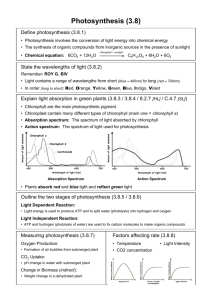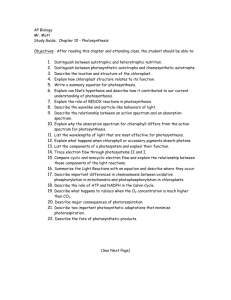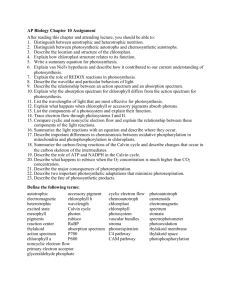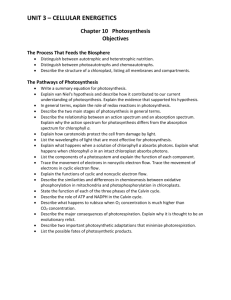Chapter 10 Photosynthesis Part 1
advertisement
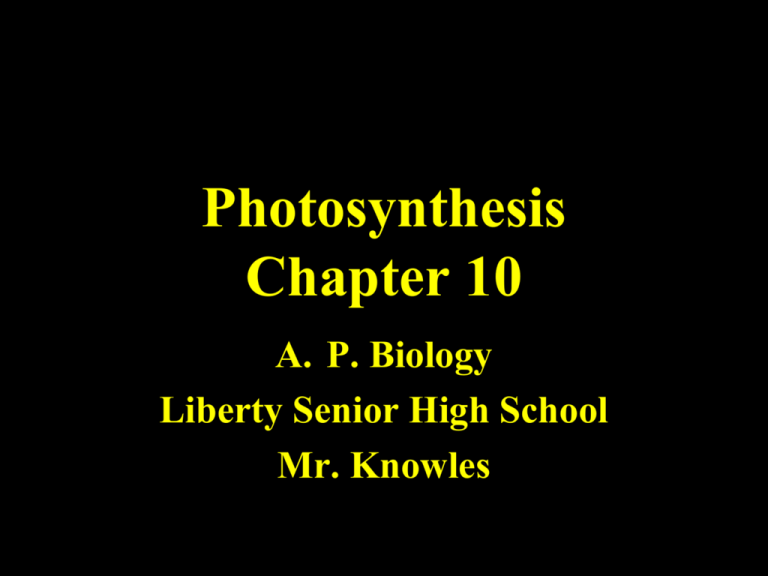
Photosynthesis Chapter 10 A. P. Biology Liberty Senior High School Mr. Knowles Question: Does eating carrots really improve your vision? • Photosynthesis – Occurs in plants, algae, certain other protists, and some prokaryotes (photoautotrophs). These organisms use light energy to drive the synthesis of organic molecules from carbon dioxide and (in most cases) water. They feed not only themselves, but the entire living world. (a) On land, plants are the predominant producers of food. In aquatic environments, photosynthetic organisms include (b) multicellular algae, such as this kelp; (c) some unicellular protists, such as Euglena; (d) the prokaryotes called cyanobacteria; and (e) other photosynthetic prokaryotes, such as these purple sulfur bacteria, which produce sulfur (spherical globules) (c, d, e: LMs). (a) Plants (c) Unicellular protist 10 m (e) Pruple sulfur bacteria Figure 10.2 (b) Multicellular algae (d) Cyanobacteria 40 m 1.5 m • Plants are photoautotrophs – They use the energy of sunlight to make organic molecules from water and carbon dioxide Figure 10.1 Chloroplasts: The Sites of Photosynthesis in Plants • Leaves are the major sites of photosynthesis Leaf cross section Vein Mesophyll Stomata Figure 10.3 CO2 O2 • Chloroplasts – Are the organelles in which photosynthesis occurs; contain thylakoids and grana Mesophyll Chloroplast 5 µm Outer membrane Thylakoid Stroma Granum Intermembrane space Thylakoid space Inner membrane 1 µm Chloroplasts Photosynthesis • < 1.0 % of sun’s energy that strikes Earth is converted into 150 billion metric tons of sugar. • In cellular respiration, electrons are transferred from sugar to oxygen; they lose potential energy to make ATP. • In photosynthesis, electrons from water gain potential energy as they are transferred to carbon dioxide to make sugar; the energy is provided by light. Free Energy G C6H12O6 + O2 CO2 + H2O Rxn Time Historical Perspective • 17th Century: van Helmont measured willow tree growth; compared mass of tree to mass of soil. • Late 18th Century: J. Priestly “restores” air in a vacuum with mint. • 18th Century: Ingenhousz found air only restored in the presence of sunlight; hypothesized CO2 C + O2 Role of Water • 1930’s: Van Niel studied purple sulfur bacteria that performed photosynthesis w/o water: CO2 + 2 H2S + Light Energy (CH2O) + H2O +2 S • The H2S serves an electron donor. • H2O serves as donor in green plants. Role of Water • In the 1950’s: used ( an isotope of oxygen ) in water to trace oxygen in the reaction. • 6 CO2 + 12 H218O + Light Energy C6H12O6 + 6 18O2 + 6 H2O 18O The Role of Light • In 1900’s, F. F. Blackman determined that photosynthesis occurred in two steps. • Initial set of reactions were dependent on light- “Light Reactions” or Light-Requiring Reactions. • A second set of reactions were independent of light-”Dark Reactions” or Non-Light Requiring Reactions- affected by temperature. • Dark Reactions use enzymes. The Splitting of Water • Chloroplasts split water into – Hydrogen and oxygen, incorporating the electrons of hydrogen into sugar molecules Reactants: Products: Figure 10.4 12 H2O 6 CO2 C6H12O6 6 H2O 6 O2 The Biophysics of Light • Light consists of units of energyPhotons. • Not all photons have the same amount of energy. • Photons travel in waves; higher the energy the shorter the wavelength (measured in nm, lambda). • The electromagnetic spectrum – Is the entire range of electromagnetic energy, or radiation 10–5 nm 10–3 Gamma rays 103 1 nm nm X-rays UV 106 nm Infrared 1m 106 nm nm Microwaves 103 m Radio waves Visible light 380 450 500 Shorter wavelength Higher energy Figure 10.6 550 600 650 700 Longer wavelength Lower energy 750 nm – Reflect light, which include the colors we see Light Reflected Light Chloroplast Absorbed light Granum Transmitted light Figure 10.7 Absorption Spectrum • The chemical nature of the molecule light hits determines if the energy is absorbed. • Each molecule has a characteristic range of photons – absorption spectrum – it can absorb. • Spectrophotometer – Is a machine that sends light through pigments and measures the fraction of light transmitted at each wavelength. • An absorption spectrum (with a spectrophotometer) – Is a graph plotting light absorption versus wavelength Refracting prism White light Chlorophyll solution Photoelectric tube Galvanometer 2 3 1 0 100 4 Slit moves to pass light of selected wavelength Green light The high transmittance (low absorption) reading indicates that chlorophyll absorbs very little green light. 0 Blue light Figure 10.8 100 The low transmittance (high absorption) reading chlorophyll absorbs most blue light. Energy Absorption • Pigments are molecules that absorb visible light well. • Two kinds of photosynthetic pigments: Carotenoids • Carotenoids- yellow and orange pigments that are highly efficient at absorbing a broad range of energies. Ex. Beta-carotene in carrots. • Ex. Xanthophylls are an oxygenated form of carotene. These are accessory pigments. • Other carotenoids are found in petals, birds and shrimp • Accessory pigments – Absorb different wavelengths of light and pass the energy to chlorophyll a Beta-Carotene Chlorophylls • Cholorophyllschlorophyll a and b- absorb narrow ranges of spectrum but highly efficient. Chlorophyll a is the major photosynthetic pigment. • Chlorophyll a – Is the main photosynthetic pigment • Chlorophyll b – Is an accessory pigment CH3 in chlorophyll a CHO in chlorophyll b CH2 CH C C H C C N N C C N C C C C H N H H CH2 C O O C C C C C O H C C CH2 CH2 C Mg C H3C C C C H3C CH3 H CH3 Porphyrin ring: Light-absorbing “head” of molecule note magnesium atom at center CH3 O O CH3 CH2 Hydrocarbon tail: interacts with hydrophobic regions of proteins inside thylakoid membranes of chloroplasts: H atoms not shown Figure 10.10 • The absorption spectra of three types of pigments in chloroplasts EXPERIMENT Three different experiments helped reveal which wavelengths of light are photosynthetically important. The results are shown below. RESULTS Absorption of light by chloroplast pigments Chlorophyll a Chlorophyll b Carotenoids Wavelength of light (nm) (a) Absorption spectra. The three curves show the wavelengths of light best absorbed by three types of chloroplast pigments. Figure 10.9 • The action spectrum of a pigment Rate of photosynthesis (measured by O2 release) – Profiles the relative effectiveness of different wavelengths of radiation in driving photosynthesis (b) Action spectrum. This graph plots the rate of photosynthesis versus wavelength. The resulting action spectrum resembles the absorption spectrum for chlorophyll a but does not match exactly (see part a). This is partly due to the absorption of light by accessory pigments such as chlorophyll b and carotenoids. • The action spectrum for photosynthesis – Was first demonstrated by Theodor W. Engelmann Aerobic bacteria Filament of alga 400 500 600 700 (c) Engelmann‘s experiment. In 1883, Theodor W. Engelmann illuminated a filamentous alga with light that had been passed through a prism, exposing different segments of the alga to different wavelengths. He used aerobic bacteria, which concentrate near an oxygen source, to determine which segments of the alga were releasing the most O2 and thus photosynthesizing most. Bacteria congregated in greatest numbers around the parts of the alga illuminated with violet-blue or red light. Notice the close match of the bacterial distribution to the action spectrum in part b. CONCLUSION Light in the violet-blue and red portions of the spectrum are most effective in driving photosynthesis. Excitation of Chlorophyll by Light • When a pigment absorbs light – It goes from a ground state to an excited state, which is unstable e– Excited state Heat Photon (fluorescence) Photon Figure 10.11 A Chlorophyll molecule Ground state • If an isolated solution of chlorophyll is illuminated – It will fluoresce, giving off light and heat Figure 10.11 B
